Image Credit: Energy Vanguard
Image Credit: Energy Vanguard A manometer measures pressure differences and can help you find out if you have unbalanced duct leakage. Watch what happens to the pressure difference between the conditioned space and outdoors when you turn the air handler on. If the pressure goes negative, you have more supply leakage. If it goes positive, you have more return leakage. If it doesn't change, your duct leakage is the same on the supply and return sides.
Image Credit: Energy Vanguard
Duct leakage is a big deal. It’s one of the top three energy wasters in most homes (air leakage and cable TV set-top boxes being the other two). Researchers at Lawrence Berkeley National Lab found that duct systems leak on average about 10% of the supply air they move and 12% of the return air. (Download pdf and also see Dana Dorsett’s comment below, #1.) In far more homes than you might suspect, the main culprit is a disconnected duct, as shown in the photo at right, but a typical duct system has a lot of other leaks, too. But another problem occurs with the duct leakage to cause even more wasted energy.
Where do the ducts leak?
In addition to how much air is leaking from the ducts, you need to know where it leaks. Leakage inside the building enclosure isn’t so bad because it’s still in the conditioned space. You still don’t want much of it, though, because it can cause comfort problems and maybe a little extra energy use. Leakage outside — in an unconditioned attic, crawl space, basement, or garage — is what you really pay for… and sometimes you pay twice. Here’s why.
Whether the ducts leak inside or outside the building enclosure is only one leakage location that matters. Your home is also affected by how much leakage occurs on the return side and the supply side of the duct system. Take a look at the diagram below.

In this case, all of the leakage is on the return side of the duct system, the side that pulls air back to the furnace, air conditioner, or heat pump to be heated or cooled. Without looking below, what do you think return leakage by itself does to the pressure in the house?
On the other hand, the duct leakage could be all on the supply side, the ducts that send conditioned air back into the house. The diagram below shows that scenario. How do you think the pressure in the house is affected by this type of duct leakage?

Are you unbalanced?
Well, let’s put some numbers on it and take a look. First, let’s assume we have a 2.5 ton air conditioner and further assume it’s moving 1,000 cubic feet per minute (cfm) of air. On the supply side, the ducts are putting 1,000 cfm of air back into the house because there’s no leakage. On the return side, let’s say we have 100 cfm of leakage. That means in this case, the return ducts are pulling in 100 cfm of air from the unconditioned attic. Since 1,000 cfm total is going through the air handler, it has to pull 900 cfm from the house.
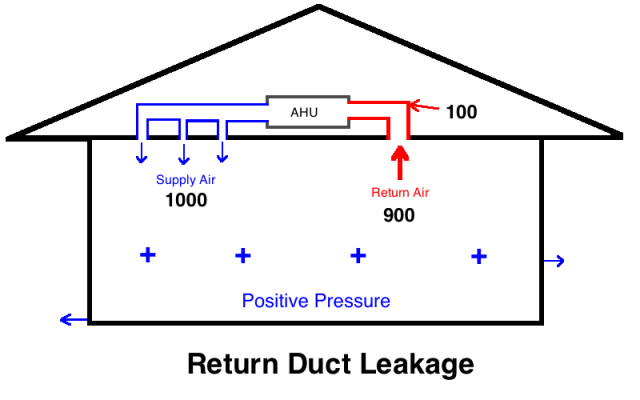
Hmmmm. Pulling 900 cfm from the house and putting 1,000 cfm into the house. The pressure is higher inside the house than the pressure outdoors. We say the indoor pressure is positive. That extra air’s gotta go somewhere, so it leaks out. We get more exfiltration from the house when this system is running than when it’s off.
Another possibility here is that the positive pressure in the house reduces the air flow in the HVAC system. We still have unbalanced duct leakage and a positive pressure and more exfiltration. But instead of 1,000 cfm total moving through the system, we might get only 950 cfm because the blower just can’t push as much air against that extra pressure in the house.
Most blowers are already fighting against the extra pressure in the duct system. The National Comfort Institute has done a lot of air flow testing, and they’ve found the typical restrictive duct system results in a total external static pressure (TESP) of 0.8 inch of water column (iwc) whereas the standard blower is rated for a maximum TESP of 0.5 iwc.
Now let’s look at the supply ducts.

Assuming 200 cfm of supply duct leakage here, we end up with a negative pressure in the house and more infiltration. Again, we may have less air flow in the HVAC system, too.
The two scenarios I described above have either all return duct leakage or all supply duct leakage, but all that really matters is that you have unbalanced duct leakage. You’re most likely going to have leakage on each side.
A shocking mnemonic
I don’t know who first said it, but I think pretty much everyone who goes through a home energy rater class learns an easy way to remember what happens.
Return leaks blow.
Supply leaks suck.
Now you’ll never forget it. Right?
How to find out if you have unbalanced duct leakage
An easy way to find out if you have unbalanced duct leakage is to turn on the air handler and see what happens to the house pressure. You can do that in more than one way, of course. You could use a manometer, if you have one.
That’s what Jessica is using in the photo below. You set it up to measure the pressure in the house with reference to the outdoor pressure. If the number is positive, you have more return duct leakage than supply duct leakage. If negative, you have more supply duct leakage than return duct leakage.
Another way to determine if you have unbalanced duct leakage is to use what Joe Lstiburek calls the “look, lick, and squirt test.” With the air handler running, you can look for evidence of air movement in spider webs or tissue paper. You can also lick your fingers and hold them in a slightly cracked door to feel if air is moving through the opening. Or you can squirt a little bit of smoke near the opening.
If you’re a professional, though, you should heed Joe’s advice about this test: Never let the client see you licking your hands.
Finding balance
So what do you do if you have unbalanced duct leakage? Well, the quickest solution would be to balance it by poking some holes in the less leaky side of the duct system. That’s a terrible idea, though, and I want you to forget you ever heard it. And don’t think of a pink elephant either!
No, the real way to fix it is to seal the duct leaks. But be careful! Sealing a duct system may result in some unintended consequences that could be worse than the problem you’re fixing. If you have a restrictive duct system, you could reduce the air flow enough to freeze the evaporator coil, burn out the compressor, or crack the heat exchanger.
Duct sealing has to be done in conjunction with air flow measurements and a complete duct system retrofit or replacement.
Another teaser
I’ve been meaning to write this article for a long time. I finally got the inspiration to write it because I need it to support an article I’m going to publish soon, probably next week. I recently got asked what I thought about a project on Kickstarter, and I was aghast at what I saw. I mentioned it in my article on the Aros smart window air conditioner, and now you know it’s related to unbalanced duct leakage. Can you guess what the idea is?
Allison Bailes of Decatur, Georgia, is a speaker, writer, energy consultant, RESNET-certified trainer, and the author of the Energy Vanguard Blog. Check out his in-depth course, Mastering Building Science at Heatspring Learning Institute, and follow him on Twitter at @EnergyVanguard.
Weekly Newsletter
Get building science and energy efficiency advice, plus special offers, in your inbox.

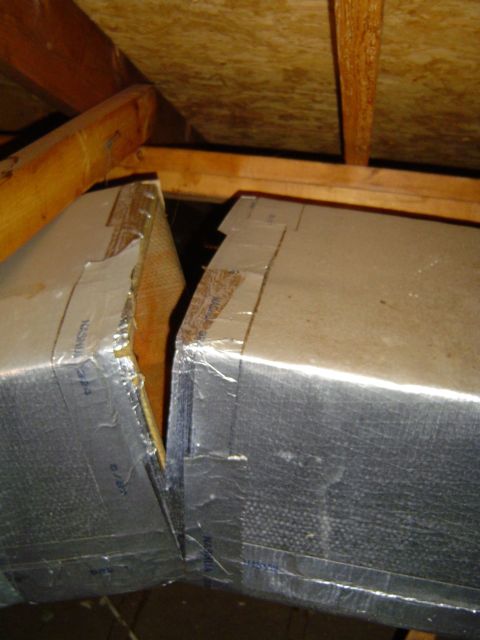




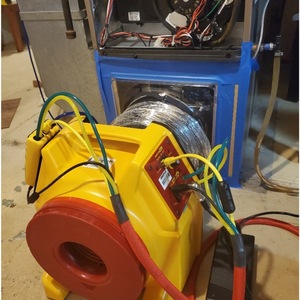

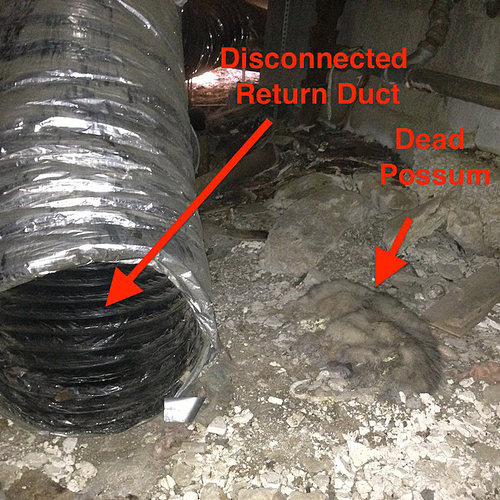
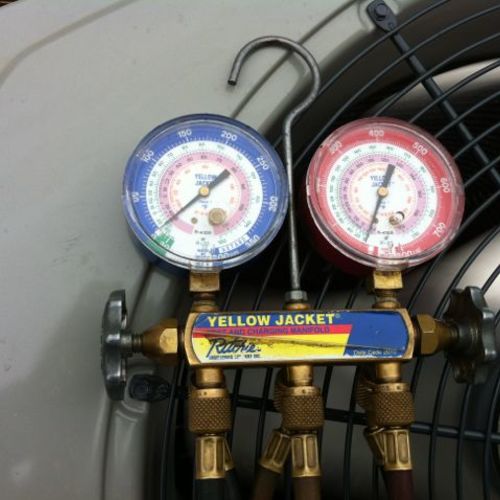






11 Comments
Rumors spread wildly.
"The U.S. Department of Energy did a study a few years ago and found that duct systems leak about 40% of the air they're moving.
Show me that study!
Lawrence Berkeley Nat'l Labs in-situ leakage surveys have had example cases as high as 40% or more, but the averages half that, consistent with the results of other large in-situ surveys. See the summary beginning on the last paragraph on p.10 (p12 in PDF pagination) http://epb.lbl.gov/publications/pdf/lbnl-47214.pdf :
"The DeltaQ test shows that the average
leakage for these houses is typical of those
seen in previous surveys (Cummings et al.
(1990), Downey and Proctor (1994a), Jump
et al. (1996a) and Modera and Wilcox
(1995)) with 99 cfm (47 l/s or 10% of air
handler flow) for supply and 107 cfm (51 l/s
or (12% of air handler flow)) for returns.
The supply leakage ranged from zero to 330
cfm (156 l/s or 35% of air handler flow).
The return leakage ranged from zero to 600
cfm (283 l/s or 73% of air handler flow). "
A field survey average leakage of 10% supply/ 12% return adds up to AT MOST 22% for a typ. number, not 40%. But the extreme cases of 35%/73% are truly the stuff of energy nightmares.
Duct leakage volumes & locations do matter from an energy consequences point of view:
http://www.aivc.org/sites/default/files/airbase_3618.pdf
And the methods of duct sealing also matter:
http://www.osti.gov/scitech/servlets/purl/776574
Response to Dana Dorsett
I should have done more research on this before throwing that number out there. I'll fix the intro of the article as soon as I finish posting this comment.
Thanks for keeping me honest, Dana.
I'm a bit surprised Sam Rashin is using those numbers.
Sam Rashkin is after all "... chief architect of the Building Technologies Office in the U.S. Department of Energy’s Office of Energy Efficiency and Renewable Energy...", and the article is attributing him with the unsupported statement that "Basic research from DOE uncovered that about 30-40 percent of the air traveling through ducts leaks,”.
Is there any way to put HIS feet to the fire on this? If that alleged "Basic research from the DOE.." exists, it's worth knowing the details, since the numbers are way over the top of literally dozens of other field surveys, both D.O.E. sponsored and others. Someone with his credentials and position shouldn't be shooting from the hip like that- it reads like marketing fluff from a duct sealing contractor, and if HE is making those statements, those contractors can be forgiven for quoting him, even if it's a gross overstatement of the typical.
Response to Dana Dorsett
Dana,
It's possible to find research studies (field studies) that report duct leakage as high as Allison quotes. But 40% is probably high if one is talking about average leakage for new construction across the country.
A famous Fort Collins, Colorado study in 2001 found shockingly high duct leakage in new homes: "A 2001 study in Fort Collins, Colorado, tested 80 new homes and discovered that not one of them complied with their code, which relied on visual inspection. Moreover, the average duct leakage in those homes was 75% of total system airflow." (More information on the Fort Collins study can be found in an article -- "Is It There? Does It Work?" -- published in the September 2001 issue of Energy Design Update.)
Reporting on a related matter -- how much energy is lost due to duct leakage in attics -- here is what I reported in 2011: “According to Dave Roberts and Jon Winkler, engineers at the National Renewable Energy Laboratories, ducts in unconditioned attics waste about 20% of the output of a furnace or air conditioner. These researchers report that during peak conditions, the losses are even greater. Roberts and Winkler wrote that in Houston, Phoenix, and Las Vegas, ‘The average DSE [distribution system efficiency] for the three locations on the design day, which would be considered the day of the season when cooling demand is highest, is 72%. This means that on the hottest day of the summer, 28% of the air-conditioner output is ultimately lost.’ ”
Whatever the number, duct leakage is significant
I just changed the intro to point to the LBNL study rather than Sam Rashkin's comment. I've heard for years about a DOE study that found 40% leakage, but I don't know if I've ever actually seen it. I know from my own duct leakage testing that the leakage can vary widely. The older the duct system, the leakier it is, especially if it has panned joist returns or old, unsealed hardpipe. I've had a 30 year old hardpipe system fall apart on me when I took the the insulation off (see photo below).
Whether we talk about averages or extremes, duct leakage is a huge energy waster in most existing homes and even some new homes. The good news is that it's improving because of code requirements for duct leakage testing. In Georgia, we've had mandatory testing for 3 years now, and all new homes have to come in at 8 cfm25 per 100 square feet of conditioned floor area to get a certificate of occupancy.
More duct leakage info
Paul Francisco emailed me about the 40% claim as well and provided another great resource on duct leakage: Peer-reviewed papers from the Illinois Sustainable Technology Center.
OK, show me the Fort Collins study too!
A 75% fleet average duct leakage on 80 homes is an epic disaster, but I could not find a hint of source information online.
The link to the UC Davis paper indicating 20% leakage doesn't work (but 20% is a more credible number, consistent with Lawrence Berkeley and other duct leakage studies.)
I'm not arguing AT ALL that duct leakage isn't a huge problem (a 20% leak is an energy disaster in an unconditoined attic), only that most of the bigger numbers bandied about often have some of the characteristics of urban myth: Everybody talks about them, but it's hard to find the actual source.
Looking at the actual source with all of the particulars is important. A lot of the peer-reviewed LBNL work done by real scientists shows very different averages than the alleged Fort Collins study, but DO find the extremes in the 75% range as well. A 75% duct loss on 80 homes where many of the ducts were badly hacked (and now disallowed by code in most places) panned joists or stud bays isn't as interesting as if that were the result using hard piping was installed correctly except for the seam/joint/boot sealing. I can imagine a tract home builder using poorly implemented framing bay ducts with leakage in that range, but it's hard to imagine 75% duct leakage with hard piped ducts that are actually hooked up (unlike the one in Allison's picture.)
In their crowing about their lab-developed aerosol based sealing methods (http://www2.lbl.gov/tt/success_stories/articles/aeroseal.html) the folks at Lawrence Berkeley Nat'l Labs estimate:
"If every home in the United States sealed its leaky HVAC ducts, the nation would save $5 billion annually in energy costs. Typical ductwork systems, both residential and commercial, lose 25-40 percent of heating and cooling energy; even newly installed systems experience 10-30 percent leakage. "
Elsewhere in similar hype (http://www2.lbl.gov/Science-Articles/Archive/leakyducts-billions.html ) they caption an attic flex-duct medusa picture with:
"IN A TYPICAL RESIDENCE, DUCT LEAKS RESULT IN ENERGY LOSS OF 20 TO 40 PERCENT"
That's energy loss, percentage, not duct leakage, but 40% is still the upper bound of "typical", not the average.
To validate some of their test methods, the LBNL folks tested 87 houses with 2 different methods, with an average leakage of 22% total air handler flow using one method, 20%. See Table 3:
http://aceee.org/files/proceedings/2002/data/papers/SS02_Panel1_Paper26.pdf
OK, 10-30 percent leakage for new-ish stuff, 20% being smack-dab in the middle, figure it gets beat up a bit over time it'll go up, not down, call it 25% instead of 20% over time. But it would have to take gross defects like missing or broken ducts to hit a 75% loss. ( I'm sure there have been tract builders that sloppy.) The 90 year old hard ducts in my house were not sealed when I moved in (never had been.) They whistled & leaked like a sieve- it was probably north of 25% duct leakage, but no way was it 75%. (I didn't test them, but went through several gallons of mastic dealing with it.) Fortunately they are all inside of conditioned space- the energy losses were/are nowhere near as big as the duct leakage.
If one tested all of the residential duct systems in the US and plotted the distribution I suspect the 1-sigma tick might be be somewhere in the 40% leakage range, and 75% is probably near the 2-sigma mark. I'm sure there are some even worse than that (say, a system with 2" of free air between the air handler and supply duct or something? :-) ), but it's hard to imagine how anyone would build it that way, or not notice when it fell apart later.
Fort Collins study
From Energy Design Update, September 2001:
"Is It There? Does It Work?"
Colorado Field Study Uncovers Serious Shortfalls
by Steve Andrews
"Fort Collins, Colorado, is a college town north of Denver with lots of Hewlett-Packard high-tech engineers among its 120,000+ inhabitants. The housing market there is red hot. But conventional wisdom about the performance of the community’s new homes is about to get seriously rattled. A soon-to-be-released study conducted by the City of Fort Collins Utilities shows that energy performance in recently built homes falls far short of reasonable performance expectations. Here’s how Doug Swartz, energy services engineer with Fort Collins Utilities and author of the report, summarizes the situation: “We’ve got a progressive energy code in Fort Collins. New home specs look pretty good and energy ratings are quite respectable. Yet this study shows that many new homes don’t work very well. Comfort problems are rampant. Combustion safety and indoor air quality [IAQ] in general are wild cards. A number of factors raise questions about durability of the building and equipment. Typical buyers have no idea — they focus on price, square footage, and amenities, and assume that everything else has been ‘taken care of by the builder and the code’ and that the house will ‘work.’ Not a good assumption.”
"... Conducted in 1999, the Fort Collins study had two purposes: assess the results following implementation of a 1996 energy code and document how new homes were designed, built, and performing. The study incorporated four criteria: health and safety, comfort, energy efficiency, and durability. Major components of the study included: inspection of 20 homes under construction; market research with 20 general contractors; phone interviews with 150 homeowners; on-site energy ratings, detailed energy modeling, and utility bill analysis of 80 new homes; and detailed performance testing in a subset of 40 homes. Performance testing included pressure diagnostics, air leakage testing, duct leakage testing, heating and cooling equipment performance indicators, and combustion safety testing.
"The study and report revolved around two key questions: “Is it there?” and “Does it work?” The first relates to energy features required by the code, and the answer was “sort of.” For example, newly required basement insulation was present 90% of the time, and the newly approved unvented crawlspace design was widely adopted. But noncompliant features were relatively commonplace. Three examples:
1. Some insulation guidelines were routinely ignored.
2. No ductwork came remotely close to meeting the code’s “substantially airtight” requirement.
3. Draft-blocking material required behind tubs, showers, and fireplaces against outside walls was hit-or-miss.
"...Ductwork problems. If HVAC problems are commonplace in Colorado, ductwork in forced-air systems is the weakest link. The emerging national standard for ductwork leakage is between 6% and 10% of total system flow when intentional openings are sealed; by contrast, duct leakage in Front Range homes averages around 75% of system flow — on the order of 10 times leakier than maximum recommended duct leakage. Testing in Fort Collins corroborates the claim that Colorado appears to have the leakiest ductwork in the nation. These duct leaks compromised heating and cooling distribution. Even with most of the ductwork nominally inside conditioned space, constrictions and leaks caused problems with comfort, building durability, and health and safety. Leaks to the outside also wasted energy. Use of building cavities for return-air flow is the prime culprit; more than 60% of the leakage is on the return-air side of furnaces. Large return-air leaks in the basement typically cause most of the negative pressure problems mentioned above...."
Who can help me locally?
Great article and perfect timing for me. I am about to move into an existing house that we just bought and our inspector found leaking ductwork in the unconditioned attic. Since I live in Minnesota, this will be a huge deal if I don't get it fixed this summer.
But who do I call? I can call the local HVAC guy, but he will probably just throw some tape around it and call it good. Who can I call in St. Paul, MN that knows EXACTLY how to fix the leaking duct and inspect all the rest of the ductwork and correctly seal and (if needed) insulate?
Supply Leaks Don't Suck
Return leaks Suck (in the air at the leak) and Supply leaks Blow (out the air at the leak)
It is true that a Return Leak to unconditioned space will cause the house to blow out conditioned air while a Supply leak to unconditioned space will cause the house to suck in unconditioned outside air. That context supports the old front door test - does the conditioned air blow your hat off when the owner opens the door?
in-re: Fort Collins study (thank you Martin.)
From the article write-up:
"The emerging national standard for ductwork leakage is between 6% and 10% of total system flow when intentional openings are sealed; by contrast, duct leakage in Front Range homes averages around 75% of system flow — on the order of 10 times leakier than maximum recommended duct leakage. Testing in Fort Collins corroborates the claim that Colorado appears to have the leakiest ductwork in the nation."
The test methodology is not well described, and the details of where & why these duct systems were leaking is mostly absent. But my suspicions about rampant poorly implemented use of panned joists & other framing as ducts seems borne out in the one-liner: "Use of building cavities for return-air flow is the prime culprit; more than 60% of the leakage is on the return-air side of furnaces. "
Even without the details I'll buy the conclusion that "...Colorado appears to have the leakiest ductwork in the nation." It's really HARD to build duct systems that leaky if even the most basic of assembly guidelines were followed. If 60% of the duct leakage was on panned-joist returns, that means 40% of the leakage (or 30% of the total air handler flow, if the total leakage is 75%) is leaking from the supply ducts. It's hard to hit those levels with ducts that are actually mechanically hooked up, even when there was no attempt to seal them.
It's not as if the LBNL et al in-situ surveys were looking at only new houses built by building scientists under laboratory conditions. While the outliers might have hit north of 70% duct leakage, the average or typ seems to be in the low 20s. While 20% leakage is a severe efficiency hit, but nothing like the efficiency & comfort disaster 40-75% would be.
The good news is that it doesn't take a building science graduate student to bring duct leakage down to single-digit percentages of total air handler flow (no rocket scientists are wasting their careers troweling on duct-mastic & caulking duct boots to wallboard/sub-floors), and right-sizing the mechanicals for the actual loads means a lower magnitude of air handler flow to start with, compared to the typical 3-5x oversized system. For the DIYers, go ahead and have at it- if your AC coils frost up as a result due to the AC being over sized (or the ducts undersized) it just means you now have to do the math (or hire a pro) on whether the right solution is to right size the ducts vs. the AC. (Duct up-sizing is usually but not always the less expensive "solution", even if the system as a whole is way oversized for the loads.) You have to start somewhere...
On a related note, zoning ducted systems will typically INCREASE overall energy use when you "turn off" a zone, due to higher duct pressures and higher induced infiltration rates. Throttling back at the registers to adjust flow for comfort makes sense, but not shutting it down entirely. This is whether the ducts are pretty-tight or very leaky- but the magnitude of the increase is larger with leaky ducts.
Log in or create an account to post a comment.
Sign up Log in